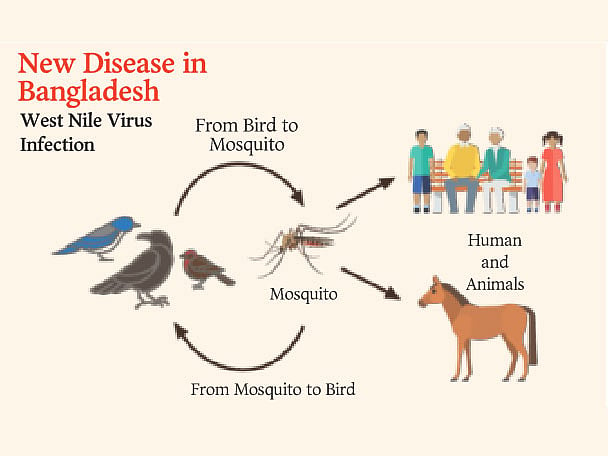New virus detected in Bangladesh

A new virus has been detected in Bangladesh, officials have confirmed.
The International Centre for Diarrhoeal Disease Research, Bangladesh (icddr,b) has found this virus on a person.
At least one and half weeks ago, icddr,b shared this matter with three government departments, officials have said. However, icddr,b declined to provide any information in this regard.
The name of the virus is West Nile Virus (WNV).
Scientists, researchers and officials have said the virus is new in Bangladesh.
The government has not started any study as to from where the virus came from. It could not be learnt how many people have been infected so far.
A consultant of a special agency of the UN has said more patients may be found if a study is carried out at the location near Dhaka where this virus has been detected. The study should be carried out without wasting any time, the consultant has suggested.
Government sources said icddr,b has written to the disease control section, the hospital section of Directorate General of Health Services (DGHS) and Institute of Epidemiology, Disease Control and Research (IEDCR).
The directors of these three departments confirmed this to Prothom Alo.
World Health Organisation (WHO) has said WNV generally remains in birds like crows. Humans are infected if an infected mosquito bites them.
No symptom of any disease is seen in eighty per cent of the infected patients. The intensity of this disease is seen when a horse is infected. The horse ultimately dies.
Disease control director professor Sanya Tahmina said, “We will request IEDCR to examine the matter further. Then we will undertake the next course of action”.
IEDCR director Meerjady Sabrina has said she has not got any request from the disease control department.
She said, “If we get any request, we will verify the matter and examine the members of the affected family and carry out the survey.”
Where did the virus come from?
According to WHO, this virus was first detected in a woman in West Nile region of Africa in 1937. This virus was detected in a bird (crow) near the river Nile in 1953.
People have been affected by this virus in many countries over the last 50 years. This disease broke out in Greece, Israel, Rumania, Russia and the United Kingdom. The infection of this disease has been found in Africa, some parts of Europe, West Asia and Australia.
This virus spread to from Tunisia and Israel to New York and affected various states of the US till 2010.
According to the website of Centers for Disease Control and Prevention of USA, WNV is the chief of mosquito born disease in USA. There is no vaccine to prevent this virus and no specific treatment for affected people. Fever and other symptoms were found in one among five affected people. The condition of one among 150 affected people becomes severe and leads to death.
How does this disease spread?
According to WHO, a mosquito gets this virus from an infected bird. In a few days, the virus in the mosquito increases. A human or animal gets infected if the infected mosquito bites. There is no instance that this disease spreads from human to human. There is also no instance that this disease migrates from mother to baby. Controlling mosquitoes is the main ways to prevent this virus.
Symptoms of disease and detection
No symptom is seen in 80 per cent of the affected people. Twenty per cent of the affected people suffer from Nile fever. The symptoms are: fever, headache, tiredness, body pain, nausea and rashes on the body.
If West Nile fever becomes severe, the symptoms like headache, high temperature and stiff neck are found and affected the patient faints. There is also a risk of paralysis.
WHO has said this virus can be detected through at least five types of tests.
Officials said except a few researchers, no one has the technology to detect this virus.
Former vice chancellor of Bangabandhu Sheikh Mujib Medical University and virus specialist Nazrul Islam said, “It is necessary to know the details of this new virus and health workers have to be apprised of this. We have to put emphasis on the elimination of mosquitoes.”
*This report, originally published in Prothom Alo print edition, has been rewritten in English by Rabiul Islam.